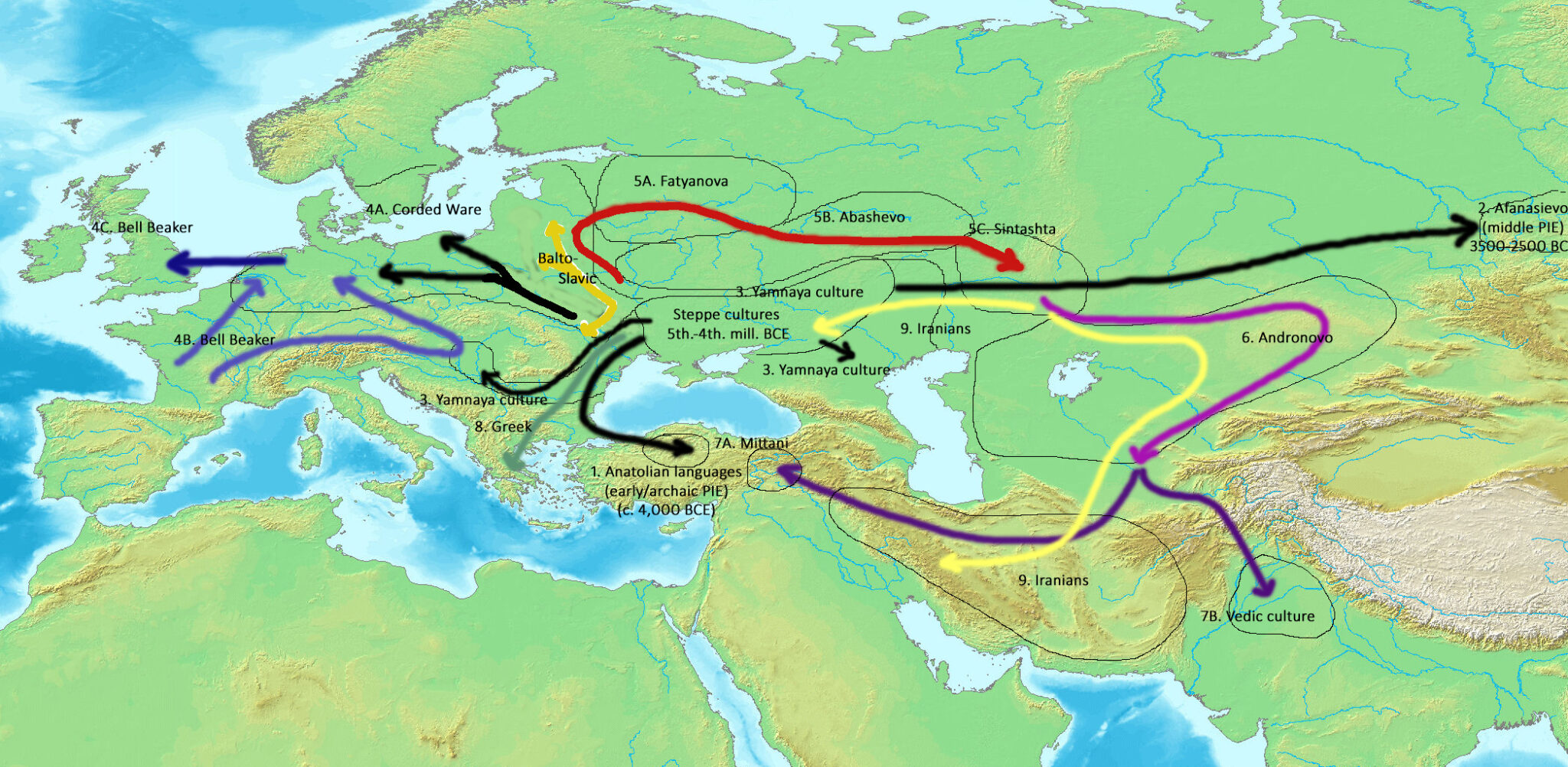Welcome to DU!
The truly grassroots left-of-center political community where regular people, not algorithms, drive the discussions and set the standards.
Join the community:
Create a free account
Support DU (and get rid of ads!):
Become a Star Member
Latest Breaking News
General Discussion
The DU Lounge
All Forums
Issue Forums
Culture Forums
Alliance Forums
Region Forums
Support Forums
Help & Search
Digging Into the Archeology of Language
Almost half of the global population now speaks a language that originated five to six thousand years ago on the steppe lands of the country we now call Ukraine.
From the outset of the Ukraine Crisis, Ukraine’s relationship with Europe and potential integration into Europe via the European Union has been a, perhaps the, cornerstone issue. I got to thinking about this over the weekend since almost every European language originated in the country we now call Ukraine. Don’t get me wrong. I don’t argue that what I’m describing has any particular relevance to the current crisis. But it’s a fascinating prism through which we can look at our connections to the distant past. The language which I am now writing and which you are now reading originated on the steppeland just north of the Black Sea and the Caspian Sea. In other words, in the region we now call Ukraine and some adjoining parts of Russia and perhaps Romania. This is true of English — a loose hodgepodge language — but not only English. All European languages except Finnish, Estonian, Hungarian and Basque start there. (Maltese, an official EU language, is derived from Arabic, a Semitic language. Turkish is an Altaic language so it depends what you count as “Europe.”) And not just Europe. This is also the origin point for the languages of Iran, much of Central Asia and northern India (including Hindi and Urdu). This is not to mention the Spanish, Portuguese and French that are spoken in the Western Hemisphere outside of Anglophone Canada and the United States.
This is the Indo-European language family which includes Germanic, Celtic, Slavic, Italic (the Romance langauges), Greek, Iranic, Indic and few other subfamilies. How this story and these interconnections were put together and how we’re pretty confident where it started is one of the most fascinating stories of human reasoning and intellection I have ever heard.
The story begins almost 250 years ago when a young Welshman who was a specialist and prodigy in the study of foreign languages, William Jones, was sent to India to learn Sanskrit as part of the British East India Company’s effort to run an Indian court system on the basis of Hindu legal precedents. The Hindu pandits of course knew Sanskrit perfectly well. But the British worried that the Indians would bamboozle them with phony precedents because they weren’t able to read the texts themselves. When Jones set to learning Sanskrit he quickly realized that this ancient language (the ancestor of Hindi and Urdu) was similar enough to Persian (which he also knew) and the Germanic languages (which include English) that they must all derive from a common ancestor. This insight sparked the birth of the modern field of linguistics. Over the next century scholars scoured the globe for languages in an effort to figure out whether they were part of the Indo-European linguistic family tree and where they fit into it. This search led to the eventual classification of the rest of the world’s languages into their own language families as well.
Along the way, specialists in the field we now call linguistics discovered a series of patterns by which languages change over time. So for instance a “kuh” sound will often evolve into an “ess” sound. But “kuh” won’t ever evolve into “puh” or “buh.” These patterns are built into the physical structure of our mouths and the circuitry of our brains. The specific rules don’t need to concern us here. But with these rules in hand these linguists were able to take the various Indo-European languages either spoken today or of which there is a written record, reverse engineer their evolution back to their common ancestor and in so doing reconstruct the language now called “proto-Indo-European” which was never written down and was spoken some five to six thousand years ago.
Think about it. That’s pretty F’ing amazing.
https://talkingpointsmemo.com/edblog/digging-into-the-archeology-of-language/sharetoken/HcBdZdj22kAr
InfoView thread info, including edit history
TrashPut this thread in your Trash Can (My DU » Trash Can)
BookmarkAdd this thread to your Bookmarks (My DU » Bookmarks)
5 replies, 1019 views
ShareGet links to this post and/or share on social media
AlertAlert this post for a rule violation
PowersThere are no powers you can use on this post
EditCannot edit other people's posts
ReplyReply to this post
EditCannot edit other people's posts
Rec (19)
ReplyReply to this post
5 replies
 = new reply since forum marked as read
Highlight:
NoneDon't highlight anything
5 newestHighlight 5 most recent replies
= new reply since forum marked as read
Highlight:
NoneDon't highlight anything
5 newestHighlight 5 most recent replies
Digging Into the Archeology of Language (Original Post)
Zorro
Mar 2022
OP
niyad
(113,278 posts)1. KNR and bookmarking. Utterly fascinating. Thank you for sharing.
ms liberty
(8,573 posts)2. Amazing. Thanks for sharing KR&B n/t
Response to Zorro (Original post)
jfz9580m This message was self-deleted by its author.
lagomorph777
(30,613 posts)4. Widespread common language in the region may go back even further.
Uncle Joe
(58,355 posts)5. Kicked and recommended.
Thanks for the thread Zorro.
